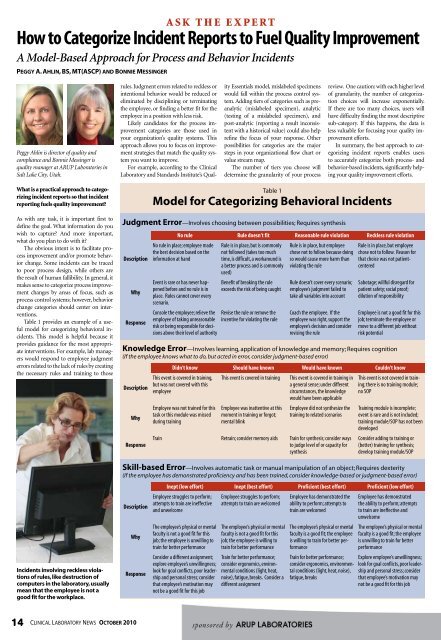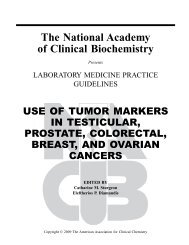oCtoBeR 2010 - American Association for Clinical Chemistry
oCtoBeR 2010 - American Association for Clinical Chemistry
oCtoBeR 2010 - American Association for Clinical Chemistry
You also want an ePaper? Increase the reach of your titles
YUMPU automatically turns print PDFs into web optimized ePapers that Google loves.
ask tHe expert<br />
How to Categorize Incident Reports to Fuel Quality Improvement<br />
A Model-Based Approach <strong>for</strong> Process and Behavior Incidents<br />
PeGGy a. aHlin, Bs, Mt(asCP) anD Bonnie MessinGeR<br />
Peggy Ahlin is director of quality and<br />
compliance and Bonnie Messinger is<br />
quality manager at ARUP Laboratories in<br />
Salt Lake City, Utah.<br />
What is a practical approach to categorizing<br />
incident reports so that incident<br />
reporting fuels quality improvement?<br />
As with any task, it is important first to<br />
define the goal. What in<strong>for</strong>mation do you<br />
wish to capture? And more important,<br />
what do you plan to do with it?<br />
The obvious intent is to facilitate process<br />
improvement and/or promote behavior<br />
change. Some incidents can be traced<br />
to poor process design, while others are<br />
the result of human fallibility. In general, it<br />
makes sense to categorize process improvement<br />
changes by areas of focus, such as<br />
process control systems; however, behavior<br />
change categories should center on interventions.<br />
Table 1 provides an example of a useful<br />
model <strong>for</strong> categorizing behavioral incidents.<br />
This model is helpful because it<br />
provides guidance <strong>for</strong> the most appropriate<br />
interventions. For example, lab managers<br />
would respond to employee judgment<br />
errors related to the lack of rules by creating<br />
the necessary rules and training to those<br />
incidents involving reckless violations<br />
of rules, like destruction of<br />
computers in the laboratory, usually<br />
mean that the employee is not a<br />
good fit <strong>for</strong> the workplace.<br />
14 CliniCal laboratory news <strong>oCtoBeR</strong> <strong>2010</strong><br />
rules. Judgment errors related to reckless or<br />
intentional behavior would be reduced or<br />
eliminated by disciplining or terminating<br />
the employee, or finding a better fit <strong>for</strong> the<br />
employee in a position with less risk.<br />
Likely candidates <strong>for</strong> the process improvement<br />
categories are those used in<br />
your organization’s quality systems. This<br />
approach allows you to focus on improvement<br />
strategies that match the quality system<br />
you want to improve.<br />
For example, according to the <strong>Clinical</strong><br />
Laboratory and Standards Institute’s Qual-<br />
ity Essentials model, mislabeled specimens<br />
would fall within the process control system.<br />
Adding tiers of categories such as preanalytic<br />
(mislabeled specimen), analytic<br />
(testing of a mislabeled specimen), and<br />
post-analytic (reporting a result inconsistent<br />
with a historical value) could also help<br />
refine the focus of your response. Other<br />
possibilities <strong>for</strong> categories are the major<br />
steps in your organizational flow chart or<br />
value stream map.<br />
The number of tiers you choose will<br />
determine the granularity of your process<br />
review. One caution: with each higher level<br />
of granularity, the number of categorization<br />
choices will increase exponentially.<br />
If there are too many choices, users will<br />
have difficulty finding the most descriptive<br />
sub-category. If this happens, the data is<br />
less valuable <strong>for</strong> focusing your quality improvement<br />
ef<strong>for</strong>ts.<br />
In summary, the best approach to categorizing<br />
incident reports enables users<br />
to accurately categorize both process- and<br />
behavior-based incidents, significantly help-<br />
ing your quality improvement ef<strong>for</strong>ts.<br />
table 1<br />
model <strong>for</strong> categorizing behavioral incidents<br />
Judgment error—involves choosing between possibilities; requires synthesis<br />
Description<br />
Why<br />
Response<br />
No rule Rule doesn’t fit Reasonable rule violation Reckless rule violation<br />
No rule in place; employee made<br />
the best decision based on the<br />
in<strong>for</strong>mation at hand<br />
Event is rare or has never happened<br />
be<strong>for</strong>e and no rule is in<br />
place. Rules cannot cover every<br />
scenario.<br />
Console the employee; relieve the<br />
employee of taking unreasonable<br />
risk or being responsible <strong>for</strong> decisions<br />
above their level of authority<br />
Rule is in place, but is commonly<br />
not followed (takes too much<br />
time, is difficult, a workaround is<br />
a better process and is commonly<br />
used)<br />
Benefit of breaking the rule<br />
exceeds the risk of being caught<br />
Revise the rule or remove the<br />
incentive <strong>for</strong> violating the rule<br />
Rule is in place, but employee<br />
chose not to follow because doing<br />
so would cause more harm than<br />
violating the rule<br />
Rule doesn’t cover every scenario;<br />
employee’s judgment failed to<br />
take all variables into account<br />
Coach the employee. If the<br />
employee was right, support the<br />
employee’s decision and consider<br />
revising the rule<br />
Rule is in place, but employee<br />
chose not to follow. Reason <strong>for</strong><br />
that choice was not patientcentered<br />
Sabotage; willful disregard <strong>for</strong><br />
patient safety; social proof;<br />
dilution of responsibility<br />
Employee is not a good fit <strong>for</strong> this<br />
job; terminate the employee or<br />
move to a different job without<br />
risk potential<br />
Knowledge error—involves learning, application of knowledge and memory; requires cognition<br />
(If the employee knows what to do, but acted in error, consider judgment-based error)<br />
Description<br />
Why<br />
Response<br />
Didn’t know Should have known Would have known Couldn’t know<br />
This event is covered in training,<br />
but was not covered with this<br />
employee<br />
Employee was not trained <strong>for</strong> this<br />
task or this module was missed<br />
during training<br />
This event is covered in training This event is covered in training in<br />
a general sense; under different<br />
circumstances, the knowledge<br />
would have been applicable<br />
Employee was inattentive at this<br />
moment in training or <strong>for</strong>got;<br />
mental blink<br />
Employee did not synthesize the<br />
training to related scenarios<br />
Train Retrain; consider memory aids Train <strong>for</strong> synthesis; consider ways<br />
to judge level of or capacity <strong>for</strong><br />
synthesis<br />
This event is not covered in training;<br />
there is no training module;<br />
no SOP<br />
Training module is incomplete;<br />
event is rare and is not included;<br />
training module/SOP has not been<br />
developed<br />
Consider adding to training or<br />
(better) training <strong>for</strong> synthesis;<br />
develop training module/SOP<br />
skill-based error—involves automatic task or manual manipulation of an object; requires dexterity<br />
(If the employee has demonstrated proficiency and has been trained, consider knowledge-based or judgment-based error)<br />
Description<br />
Why<br />
Response<br />
Inept (low ef<strong>for</strong>t) Inept (best ef<strong>for</strong>t) Proficient (best ef<strong>for</strong>t) Proficient (low ef<strong>for</strong>t)<br />
Employee struggles to per<strong>for</strong>m;<br />
attempts to train are ineffective<br />
and unwelcome<br />
The employee’s physical or mental<br />
faculty is not a good fit <strong>for</strong> this<br />
job; the employee is unwilling to<br />
train <strong>for</strong> better per<strong>for</strong>mance<br />
Consider a different assignment;<br />
explore employee’s unwillingness;<br />
look <strong>for</strong> goal conflicts, poor leadership<br />
and personal stress; consider<br />
that employee’s motivation may<br />
not be a good fit <strong>for</strong> this job<br />
Employee struggles to per<strong>for</strong>m;<br />
attempts to train are welcomed<br />
The employee’s physical or mental<br />
faculty is not a good fit <strong>for</strong> this<br />
job; the employee is willing to<br />
train <strong>for</strong> better per<strong>for</strong>mance<br />
Train <strong>for</strong> better per<strong>for</strong>mance;<br />
consider ergonomics, environmental<br />
conditions (light, heat,<br />
noise), fatigue, breaks. Consider a<br />
different assignment<br />
Employee has demonstrated the<br />
ability to per<strong>for</strong>m; attempts to<br />
train are welcomed<br />
The employee’s physical or mental<br />
faculty is a good fit; the employee<br />
is willing to train <strong>for</strong> better per<strong>for</strong>mance<br />
Train <strong>for</strong> better per<strong>for</strong>mance;<br />
consider ergonomics, environmental<br />
conditions (light, heat, noise),<br />
fatigue, breaks<br />
Employee has demonstrated<br />
the ability to per<strong>for</strong>m; attempts<br />
to train are ineffective and<br />
unwelcome<br />
The employee’s physical or mental<br />
faculty is a good fit; the employee<br />
is unwilling to train <strong>for</strong> better<br />
per<strong>for</strong>mance<br />
Explore employee’s unwillingness;<br />
look <strong>for</strong> goal conflicts, poor leadership<br />
and personal stress; consider<br />
that employee’s motivation may<br />
not be a good fit <strong>for</strong> this job
















